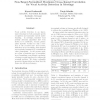Free Online Productivity Tools
i2Speak
i2Symbol
i2OCR
iTex2Img
iWeb2Print
iWeb2Shot
i2Type
iPdf2Split
iPdf2Merge
i2Bopomofo
i2Arabic
i2Style
i2Image
i2PDF
iLatex2Rtf
Sci2ools
NAACL
2007
2007
A Geometric Interpretation of Non-Target-Normalized Maximum Cross-Channel Correlation for Vocal Activity Detection in Meetings
Vocal activity detection is an important technology for both automatic speech recognition and automatic speech understanding. In meetings, standard vocal activity detection algorithms have been shown to be ineffective, because participants typically vocalize for only a fraction of the recorded time and because, while they are not vocalizing, their channels are frequently dominated by crosstalk from other participants. In the present work, we review a particular type of normalization of maximum cross-channel correlation, a feature recently introduced to address the crosstalk problem. We derive a plausible geometric interpretation and show how the frame size affects performance.
Automatic Speech | Automatic Speech Recognition | Computational Linguistics | NAACL 2007 | Vocal Activity Detection |
| Added | 30 Oct 2010 |
| Updated | 30 Oct 2010 |
| Type | Conference |
| Year | 2007 |
| Where | NAACL |
| Authors | Kornel Laskowski, Tanja Schultz |
Comments (0)

